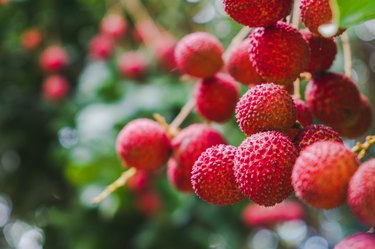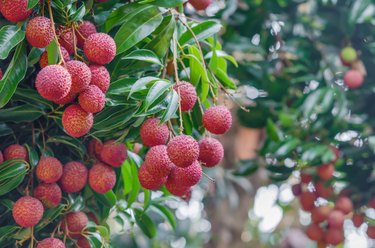
Your first experience with lychees (Litchi chinensis) probably came at the end of a meal in a Chinese restaurant. If they were bitter and sour, they were not ripe, which means they were harvested too soon, as lychee needs at least four or months to mature. Originating in the southern areas of China where it's tropical during the day and cooler at night, lychees grow best in the U.S. Department of Agriculture hardiness zones 10 and 11. If there is a probability of frost, the lychee will not survive.
Tip
If you have your own lychee tree, check that the husks are rosy pink-red, not deep red, as that means the fruit is overripe and may be entering the fermentation stage.
Video of the Day
Growing Lychee Fruit
China was the first country to cultivate the lychee, probably around 2,100 B.C. per recorded history. Guangdong Province in Southern China was the original and largest producer of the fruit. Production has expanded to include the world's tropical and subtropical belt, and altitude is significant to the successful growth of lychee. Florida, California and Hawaii are the major growers of lychee in the United States.
Video of the Day
Growing lychee from seed takes up to 10 years to bear fruit. Air-layering, in which a piece of healthy branch is attached to the mother plant until roots develop, is the preferred method of cloning a lychee tree. Root development can take from one month to one year, and when a substantial growth of roots have developed, the branch is removed, replanted into a container, and left to mature in a shady, humid spot.

Fruit Bearing Lychee
The lychee will bear fruit after several years, given the right growing temperatures and conditions. Most like a hard-chill during the winter, but not so cold as to suffer a frost. Once the spring flowers appear, fruit should be ready to harvest in about 140 days. The best barometer of ripeness is the color of the husk. It starts out yellow, changes to light pink and then darker pink. If the color is a deep magenta, you've left the cluster on the tree too long and the fruit may begin to turn.
To harvest, remove an entire cluster of lychee a few inches below the base of the cluster. It's not necessary to remove the individual lychees at this time, but remember: they no longer mature once removed from the tree. Store in a refrigerator for five – 10 days or frozen, in the husk.
Eating Lychees From the Tree

As soon as you harvest a cluster of lychees, eat them immediately as the fruit has a short shelf life. Canning is the best way to extend the life of the fruit and to transport it to areas that do not grow lychee, because these fruits don't age well. All harvesting is done by hand, including in commercial orchards. The smooth oblong fruit tastes sweet, yet slightly acidic. A slight rose scent is emitted from the fruit. The flesh is white and has a sheen similar to a pearl.
To emphasize, lychee doesn't mature once it's picked, so the time of harvesting is crucial to the overall usefulness of the fruit. Known also as a "lychee nut," the term includes the outer pink-hued shell, the inner lychee and the stone at the center of the fruit. Only the fruit is edible. Most lychee orchards are planted on hillsides as the tree abhors standing water. Harvest is from mid-May through July.